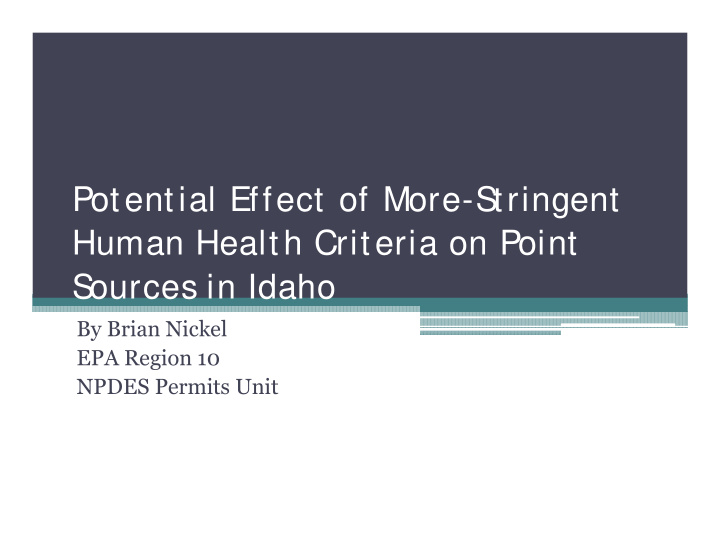



Potential Effect of More-S tringent Human Health Criteria on Point S ources in Idaho By Brian Nickel EPA Region 10 NPDES Permits Unit
Introduction • Goal ▫ A preliminary sense of which NPDES permit holders may be affected by more-stringent human health criteria in Idaho. • Process ▫ Review a sample of Idaho permits that have effluent limits and/or monitoring requirements for pollutants affected by the EPA’s disapproval action. ▫ Conduct a “reasonable potential” analysis for those permits to determine if limits may be necessary, or if current limits may need to be more stringent. ▫ Exclude pollutants with aquatic life criteria that are much more stringent than the human health criteria (e.g., cyanide and selenium).
Types of Facilities With Monitoring Requirements or Limits • Water Treatment Plants ▫ Monitoring requirements for thallium and total trihalomethanes or THM (chloroform, chlorodibromomethane, dichlorobromomethane, and bromoform) • Large Publicly Owned Treatment Works or POTWs ( ≥ 1 mgd design flow) ▫ Priority pollutant scans required for applications. • Groundwater remediation • Pulp and Paper
How the EP A Determines the Need for Effluent Limits (“ Reasonable Potential” ) • “Reasonable potential” means the projected receiving water concentration exceeds water quality criteria. ▫ Effluent data analyzed using statistics in Chapter 3 of the EPA’s Technical Support Docum ent for Water Quality-based Toxics Control (TSD). ▫ Dilution may be considered; “critical” stream flows for human health are higher than for aquatic life. ▫ More stringent criteria means “reasonable potential” is more likely.
How the EP A Calculates Limits Based on Human Health Criteria • If there is “reasonable potential,” then limits are established. ▫ Mixing zone authorized: Average monthly limit meets criteria at the edge of the mixing zone. ▫ No mixing zone authorized: Average monthly limit meets criteria at the point of discharge. ▫ More stringent criteria means more stringent limits.
Permits Reviewed: POTWs • POTW #1 ▫ 12 mgd design flow; 2.3:1 – 3.6:1 dilution ▫ Receiving water not designated for DWS • POTW #2 ▫ 3 mgd design flow; 4:1 dilution ▫ Receiving water not designated for DWS. • POTW #3 ▫ 5 mgd design flow; 17:1 dilution ▫ Receiving water designated for DWS • POTW #4 ▫ 17 mgd design flow; 19:1 – 38:1 dilution ▫ Receiving water designated for DWS
Permits Reviewed: Other Facilities • Water Treatment Plants ▫ Thallium has been monitored for but never detected. ▫ Analysis for THMs was based on total THM effluent data. ▫ Plant #1 26:1 dilution Receiving water not designated for domestic water supply (DWS) (i.e., “organisms only” criteria apply). ▫ Plant #2 11,530:1 dilution Receiving water designated for DWS (i.e., “water + organisms” criteria apply). • Pulp and Paper ▫ 6.4:1 dilution based on the fact sheet. ▫ Receiving water designated for DWS. • Groundwater Remediation General Permit ▫ Two permittees with a total of four coverages were evaluated. ▫ No mixing zone was authorized in prior coverage. ▫ Water + organisms criteria used since this is a statewide permit.
Discussion of Results: Current Criteria • The following types of facilities may need new or more stringent limits for the following pollutants: ▫ Groundwater remediation tetrachloroethylene trichloroethylene vinyl chloride fluoranthene ▫ Pulp and paper pentachlorophenol
Discussion of Results: What If Criteria are Cut in Half (50% of Current Criteria)? • Add the following: ▫ Groundwater remediation benzo(a)anthracene benzo(a)pyrene benzo(b)fluoranthene benzo(k)fluoranthene chrysene dibenzo(a,h)anthracene indeno(1,2,3-cd)pyrene
Discussion of Results: What if Criteria are Cut by a Factor of 5 (20% of Current Criteria? ) • Add the following: ▫ Water treatment plants with low dilution chlorodibromomethane dichlorobromomethane ▫ Groundwater remediation pyrene acenapthene ▫ Large POTWs carbon tetrachloride dichlorobromomethane (if receiving water is designated for DWS)
Discussion of Results: What if Criteria are Cut by a Factor of 10 (to 10% of Current Criteria)? • Add the following: ▫ Groundwater remediation fluorene ▫ Pulp and Paper 2,4,6 trichlorophenol ▫ Large POTWs dichlorobromomethane (if receiving water is not designated for DWS)
Other Potential Issues for Point S ources • Polychlorinated biphenyls (PCBs) ▫ Monitoring not currently required in any Idaho permits. ▫ Studies in Washington State: Concentrations in POTW effluents were > 64 pg/L about 90% of the time. • 2,3,7,8 TCDD (dioxin) ▫ Limited in Idaho’s only pulp and paper permit. The limits, which are based on old criteria (based on 6.5 g/day), are already below quantification limits. ▫ Detected in POTW effluents in other States.
Other Potential Issues, Cont’ d • Pesticides ▫ Yakima River (WA) Study: DDT, dieldrin, endosulfan, and chlorpyrifos were detected in fruit packing and vegetable processing effluents. Chlorpyrifos and endosulfan detected in POTW effluents. • Other types of facilities (e.g., minor POTWs) could be affected ▫ There could be a water quality impairment (i.e., 303(d) listing) and/or a total maximum daily load for one of these pollutants, for that facility’s receiving water. ▫ More stringent criteria make water quality impairments more likely.
Questions?
Recommend
More recommend